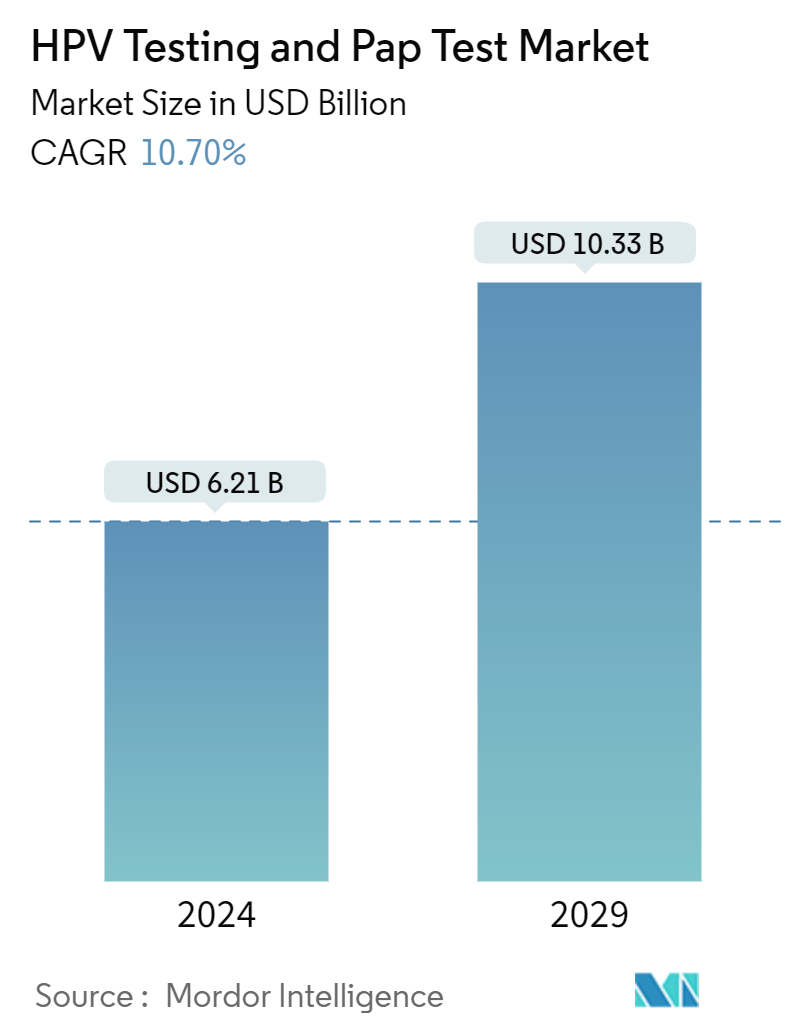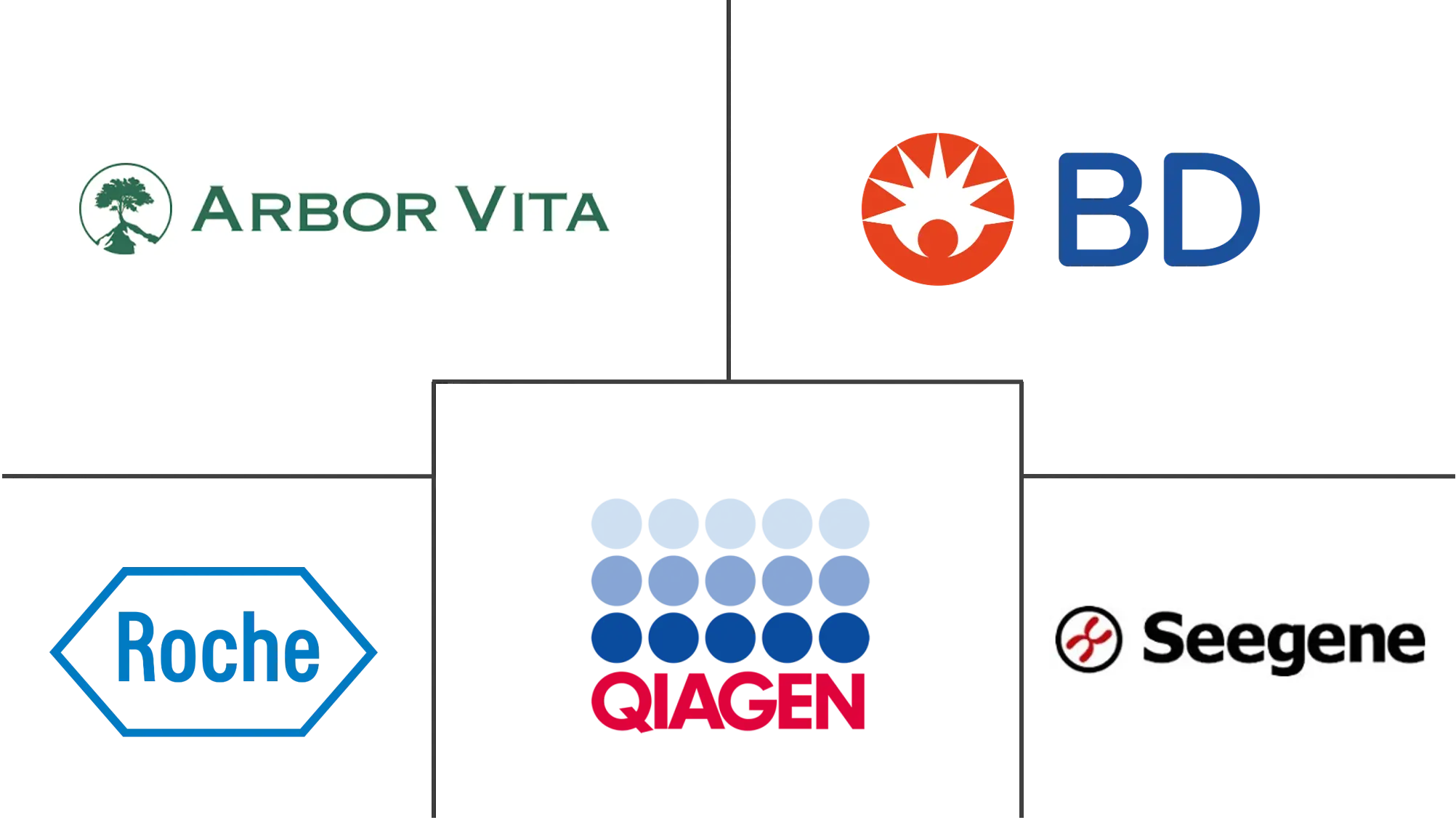Market Size of HPV Testing And Pap Test Industry

| Study Period | 2019 - 2029 |
| Market Size (2024) | USD 6.21 Billion |
| Market Size (2029) | USD 10.33 Billion |
| CAGR (2024 - 2029) | 10.70 % |
| Fastest Growing Market | Asia Pacific |
| Largest Market | North America |
Major Players
*Disclaimer: Major Players sorted in no particular order |
HPV Testing and Pap Test Market Analysis
The HPV Testing And Pap Test Market size is estimated at USD 6.21 billion in 2024, and is expected to reach USD 10.33 billion by 2029, growing at a CAGR of 10.70% during the forecast period (2024-2029).
HPV (human papillomavirus) and Pap tests are essential components of cervical cancer screening. HPV is a common sexually transmitted infection that can lead to the development of cervical cancer. Pap tests, on the other hand, involve the collection of cells from the cervix to detect any abnormal changes that may indicate the presence of precancerous or cancerous cells.
The combination of HPV testing and Pap tests has proven to be highly effective in identifying women at risk of developing cervical cancer. HPV testing can detect the presence of high-risk HPV strains, which are strongly associated with the development of cervical cancer. Pap tests, on the other hand, can identify abnormal changes in cervical cells that may indicate the presence of precancerous or cancerous cells.
However, the effectiveness of cervical cancer screening heavily relies on the demand for these tests. This is where government policies and programs play a crucial role. Governments around the world have recognized the importance of cervical cancer screening and have implemented various policies and programs to increase awareness and access to these tests. For instance, India’s interim Union Budget 2024-2025 became a symbol of optimism on the occasion of International Women’s Day, especially in terms of women’s health. The Indian administration's commendable efforts to promote the immunization of girls (aged 9 to 14) against cervical cancer have proven to be a significant step in protecting women's welfare.
Government policies often include guidelines that recommend the frequency and age at which women should undergo cervical cancer screening. These guidelines are based on scientific evidence and aim to ensure that women receive regular screenings at appropriate intervals. By setting these guidelines, governments help healthcare providers and individuals understand the importance of regular screening and the recommended age to start and stop screening.
In conclusion, HPV and Pap tests are crucial components of cervical cancer screening, and government policies and programs play a significant role in increasing the demand for these tests. By implementing guidelines, awareness campaigns, and financial support, governments contribute to the early detection and prevention of cervical cancer, ultimately saving lives.
HPV Testing and Pap Test Industry Segmentation
As per the scope of the report, the human papillomavirus (HPV) test is used to detect the presence of the human papillomavirus, which leads to the development of genital warts, abnormal cervical cells, or cervical cancer. A Pap smear, also called Pap test or smear test, is a procedure doctors use to find cell changes or abnormal cells in the cervix. A Pap smear removes a microscopic sample of cells from the cervix to test for cancer and precancer. Pap tests are the most preferred tests to detect cervical cancer. These tests include microscopic observation of specimens.
The HPV testing and Pap test market is segmented by test type, application, end user, and geography. By test type, the market is segmented into HPV test, Pap test, and co-testing. The market is segmented by application into cervical cancer screening tests, head and neck cancer screening tests, and other applications. By end user, the market is segmented into hospitals/clinics, diagnostic centers, and point-of-care/self-sampling. Geographically, the market is segmented into North America, Europe, Asia-Pacific, Middle East and Africa, and South America. The report offers the value (USD) for the above segments.
| By Test Type | |
| HPV Test | |
| Pap Test | |
| Co-testing |
| By Application | |
| Cervical Cancer Screening Tests | |
| Head and Neck Cancer Screening Tests | |
| Other Applications |
| By End User | |
| Hospitals/Clinics | |
| Diagnostic Centers | |
| Point-of-care/Self-sampling |
| By Geography | ||||||||
| ||||||||
| ||||||||
| ||||||||
| ||||||||
|
HPV Testing And Pap Test Market Size Summary
The HPV testing and Pap test market is a critical segment within the healthcare industry, focusing on the early detection and prevention of cervical cancer. These tests are integral to cervical cancer screening, with HPV testing identifying high-risk strains of the virus that can lead to cancer, and Pap tests detecting abnormal cervical cell changes. The market is driven by the increasing global burden of cervical cancer, which predominantly affects women, and the rising awareness of the importance of early detection. Government policies and programs play a pivotal role in this market by promoting awareness, providing guidelines for screening, and offering financial support to enhance access to these tests. Such initiatives are crucial in encouraging regular screenings, thereby contributing to the reduction of cervical cancer incidence and mortality rates.
The market is characterized by moderate fragmentation, with several key players employing both inorganic and organic strategies to maintain their competitive edge. These strategies include product approvals, collaborations, and expansions, which are essential for sustaining growth in the HPV testing and Pap test market. North America leads the market due to the high incidence of cervical cancer and the implementation of favorable government policies, such as the National Breast and Cervical Cancer Early Detection Program in the United States. The approval of new diagnostic assays and the development of innovative tests further bolster market growth. As awareness and demand for cervical cancer screening continue to rise, the market is poised for significant expansion during the forecast period.
HPV Testing And Pap Test Market Size - Table of Contents
-
1. MARKET DYNAMICS
-
1.1 Market Overview
-
1.2 Market Drivers
-
1.2.1 Increasing Number of Cervical Cancer Cases
-
1.2.2 Increasing Number of Cervical Cancer Screening Programs
-
1.2.3 Introduction to Advanced Technologies
-
-
1.3 Market Restraints
-
1.3.1 HPV Vaccination
-
1.3.2 Changes in Regulatory Guidelines for Cervical Cancer Screening
-
-
1.4 Porter's Five Forces Analysis
-
1.4.1 Threat of New Entrants
-
1.4.2 Bargaining Power of Buyers/Consumers
-
1.4.3 Bargaining Power of Suppliers
-
1.4.4 Threat of Substitute Products
-
1.4.5 Intensity of Competitive Rivalry
-
-
-
2. MARKET SEGMENTATION (Market Size by Value - USD)
-
2.1 By Test Type
-
2.1.1 HPV Test
-
2.1.2 Pap Test
-
2.1.3 Co-testing
-
-
2.2 By Application
-
2.2.1 Cervical Cancer Screening Tests
-
2.2.2 Head and Neck Cancer Screening Tests
-
2.2.3 Other Applications
-
-
2.3 By End User
-
2.3.1 Hospitals/Clinics
-
2.3.2 Diagnostic Centers
-
2.3.3 Point-of-care/Self-sampling
-
-
2.4 By Geography
-
2.4.1 North America
-
2.4.1.1 United States
-
2.4.1.2 Canada
-
2.4.1.3 Mexico
-
-
2.4.2 Europe
-
2.4.2.1 Germany
-
2.4.2.2 United Kingdom
-
2.4.2.3 France
-
2.4.2.4 Italy
-
2.4.2.5 Spain
-
2.4.2.6 Rest of Europe
-
-
2.4.3 Asia-Pacific
-
2.4.3.1 China
-
2.4.3.2 Japan
-
2.4.3.3 India
-
2.4.3.4 Australia
-
2.4.3.5 South Korea
-
2.4.3.6 Rest of Asia-Pacific
-
-
2.4.4 Middle East and Africa
-
2.4.4.1 GCC
-
2.4.4.2 South Africa
-
2.4.4.3 Rest of Middle East and Africa
-
-
2.4.5 South America
-
2.4.5.1 Brazil
-
2.4.5.2 Argentina
-
2.4.5.3 Rest of South America
-
-
-
HPV Testing And Pap Test Market Size FAQs
How big is the HPV Testing And Pap Test Market?
The HPV Testing And Pap Test Market size is expected to reach USD 6.21 billion in 2024 and grow at a CAGR of 10.70% to reach USD 10.33 billion by 2029.
What is the current HPV Testing And Pap Test Market size?
In 2024, the HPV Testing And Pap Test Market size is expected to reach USD 6.21 billion.

